2017 NISSAN PATHFINDER navigation system
[x] Cancel search: navigation systemPage 3 of 555
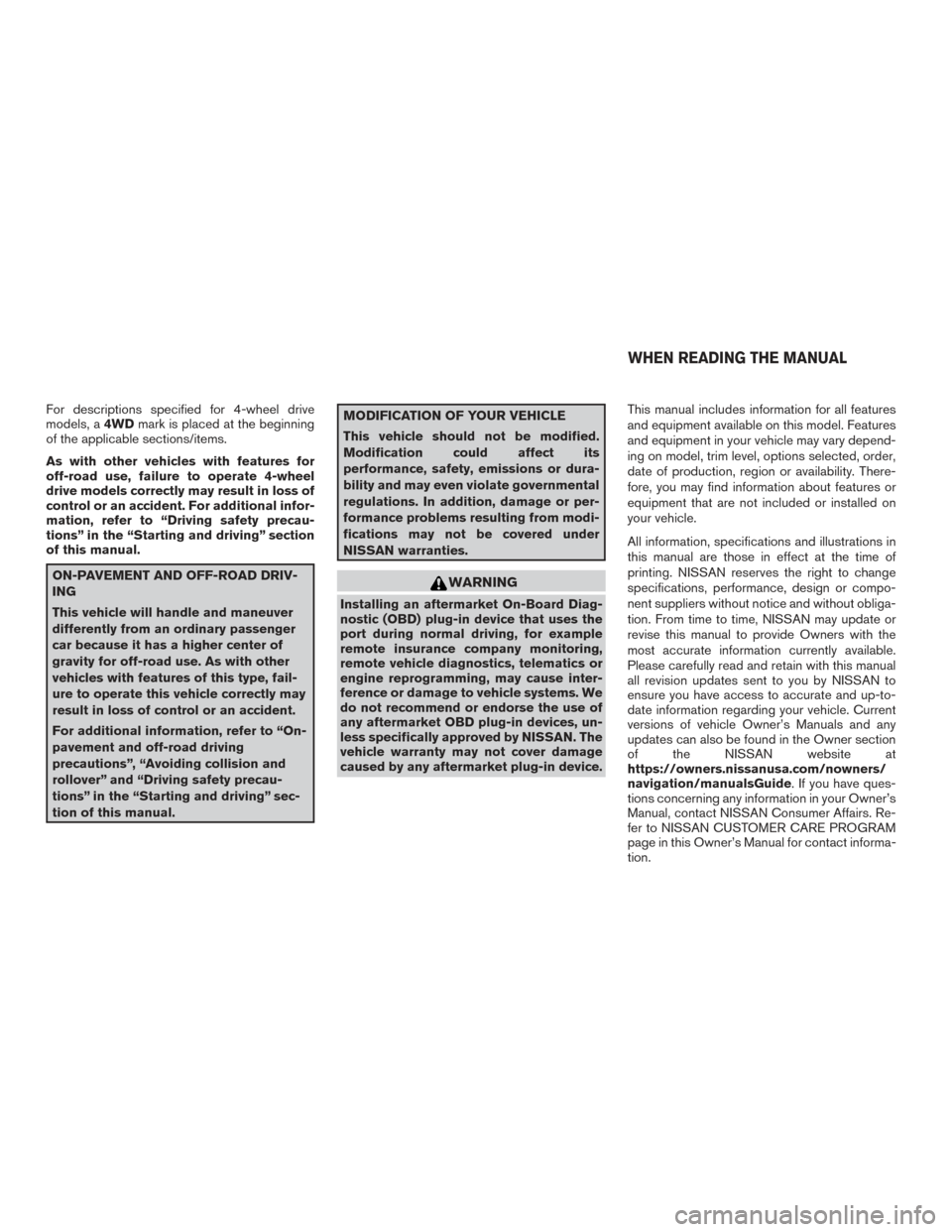
For descriptions specified for 4-wheel drive
models, a4WDmark is placed at the beginning
of the applicable sections/items.
As with other vehicles with features for
off-road use, failure to operate 4-wheel
drive models correctly may result in loss of
control or an accident. For additional infor-
mation, refer to “Driving safety precau-
tions” in the “Starting and driving” section
of this manual.
ON-PAVEMENT AND OFF-ROAD DRIV-
ING
This vehicle will handle and maneuver
differently from an ordinary passenger
car because it has a higher center of
gravity for off-road use. As with other
vehicles with features of this type, fail-
ure to operate this vehicle correctly may
result in loss of control or an accident.
For additional information, refer to “On-
pavement and off-road driving
precautions”, “Avoiding collision and
rollover” and “Driving safety precau-
tions” in the “Starting and driving” sec-
tion of this manual.
MODIFICATION OF YOUR VEHICLE
This vehicle should not be modified.
Modification could affect its
performance, safety, emissions or dura-
bility and may even violate governmental
regulations. In addition, damage or per-
formance problems resulting from modi-
fications may not be covered under
NISSAN warranties.
WARNING
Installing an aftermarket On-Board Diag-
nostic (OBD) plug-in device that uses the
port during normal driving, for example
remote insurance company monitoring,
remote vehicle diagnostics, telematics or
engine reprogramming, may cause inter-
ference or damage to vehicle systems. We
do not recommend or endorse the use of
any aftermarket OBD plug-in devices, un-
less specifically approved by NISSAN. The
vehicle warranty may not cover damage
caused by any aftermarket plug-in device. This manual includes information for all features
and equipment available on this model. Features
and equipment in your vehicle may vary depend-
ing on model, trim level, options selected, order,
date of production, region or availability. There-
fore, you may find information about features or
equipment that are not included or installed on
your vehicle.
All information, specifications and illustrations in
this manual are those in effect at the time of
printing. NISSAN reserves the right to change
specifications, performance, design or compo-
nent suppliers without notice and without obliga-
tion. From time to time, NISSAN may update or
revise this manual to provide Owners with the
most accurate information currently available.
Please carefully read and retain with this manual
all revision updates sent to you by NISSAN to
ensure you have access to accurate and up-to-
date information regarding your vehicle. Current
versions of vehicle Owner’s Manuals and any
updates can also be found in the Owner section
of the NISSAN website at
https://owners.nissanusa.com/nowners/
navigation/manualsGuide. If you have ques-
tions concerning any information in your Owner’s
Manual, contact NISSAN Consumer Affairs. Re-
fer to NISSAN CUSTOMER CARE PROGRAM
page in this Owner’s Manual for contact informa-
tion.
WHEN READING THE MANUAL
Page 15 of 555
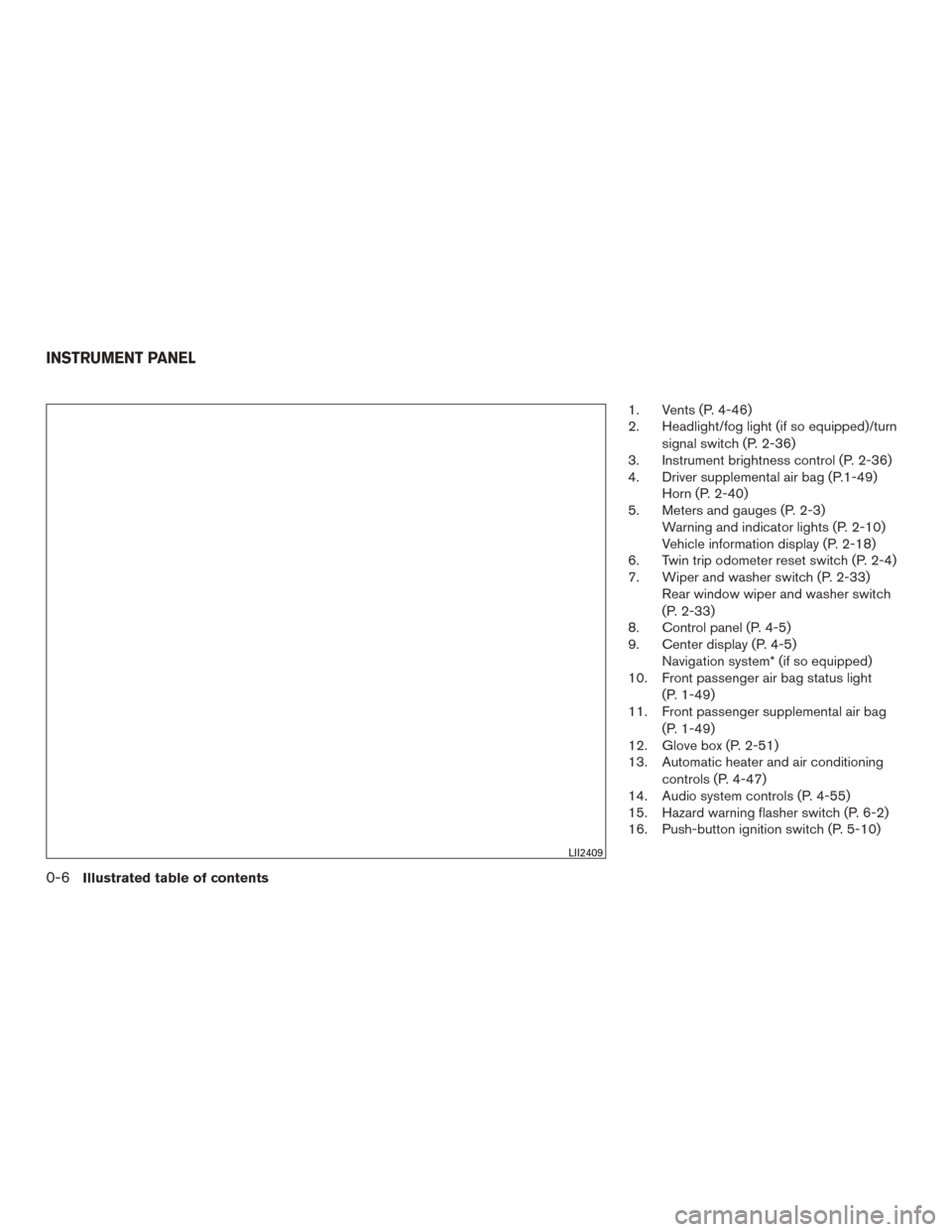
1. Vents (P. 4-46)
2. Headlight/fog light (if so equipped)/turnsignal switch (P. 2-36)
3. Instrument brightness control (P. 2-36)
4. Driver supplemental air bag (P.1-49) Horn (P. 2-40)
5. Meters and gauges (P. 2-3) Warning and indicator lights (P. 2-10)
Vehicle information display (P. 2-18)
6. Twin trip odometer reset switch (P. 2-4)
7. Wiper and washer switch (P. 2-33) Rear window wiper and washer switch
(P. 2-33)
8. Control panel (P. 4-5)
9. Center display (P. 4-5) Navigation system* (if so equipped)
10. Front passenger air bag status light
(P. 1-49)
11. Front passenger supplemental air bag
(P. 1-49)
12. Glove box (P. 2-51)
13. Automatic heater and air conditioning
controls (P. 4-47)
14. Audio system controls (P. 4-55)
15. Hazard warning flasher switch (P. 6-2)
16. Push-button ignition switch (P. 5-10)
LII2409
INSTRUMENT PANEL
0-6Illustrated table of contents
Page 16 of 555
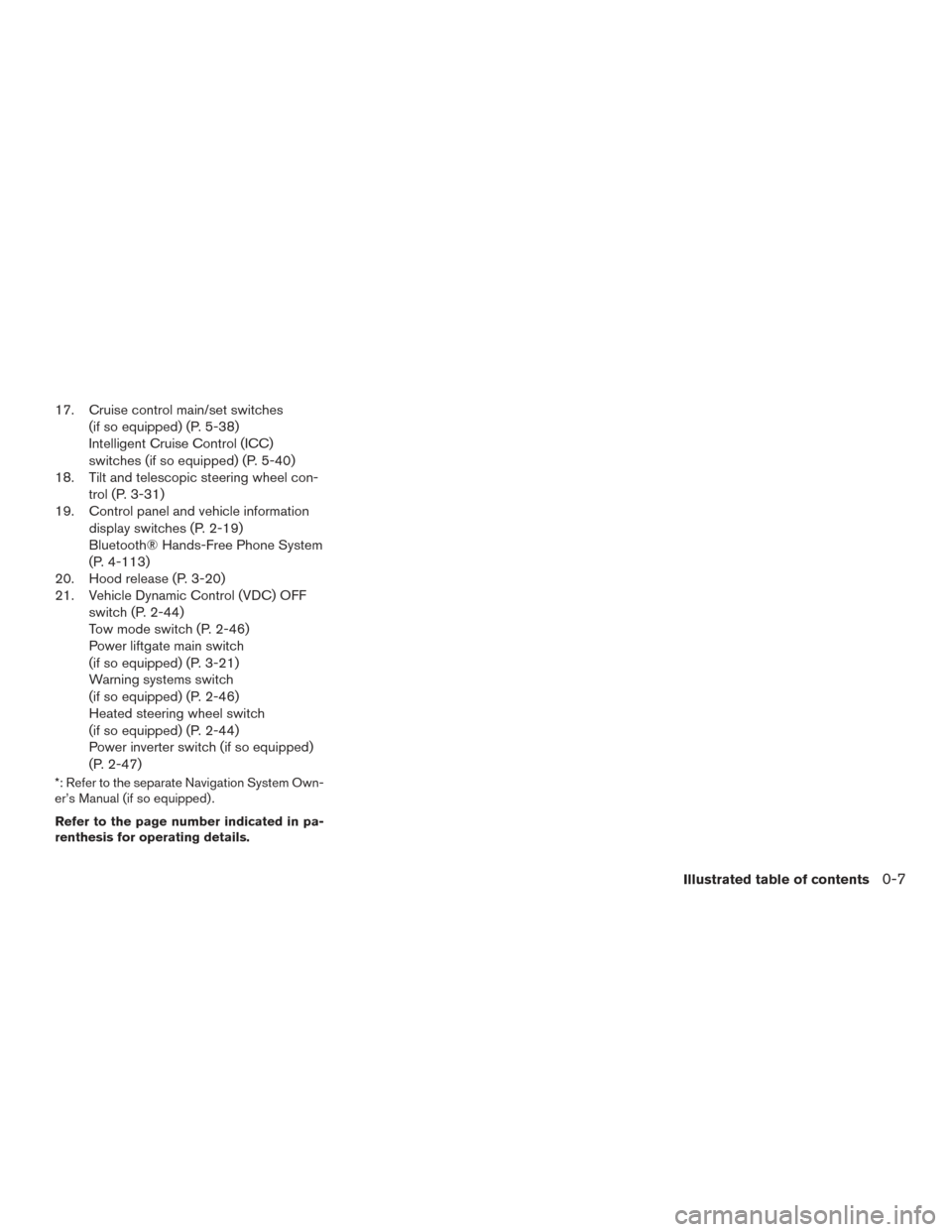
17. Cruise control main/set switches(if so equipped) (P. 5-38)
Intelligent Cruise Control (ICC)
switches (if so equipped) (P. 5-40)
18. Tilt and telescopic steering wheel con-
trol (P. 3-31)
19. Control panel and vehicle information
display switches (P. 2-19)
Bluetooth® Hands-Free Phone System
(P. 4-113)
20. Hood release (P. 3-20)
21. Vehicle Dynamic Control (VDC) OFF
switch (P. 2-44)
Tow mode switch (P. 2-46)
Power liftgate main switch
(if so equipped) (P. 3-21)
Warning systems switch
(if so equipped) (P. 2-46)
Heated steering wheel switch
(if so equipped) (P. 2-44)
Power inverter switch (if so equipped)
(P. 2-47)
*: Refer to the separate Navigation System Own-
er’s Manual (if so equipped) .
Refer to the page number indicated in pa-
renthesis for operating details.
Illustrated table of contents0-7
Page 91 of 555
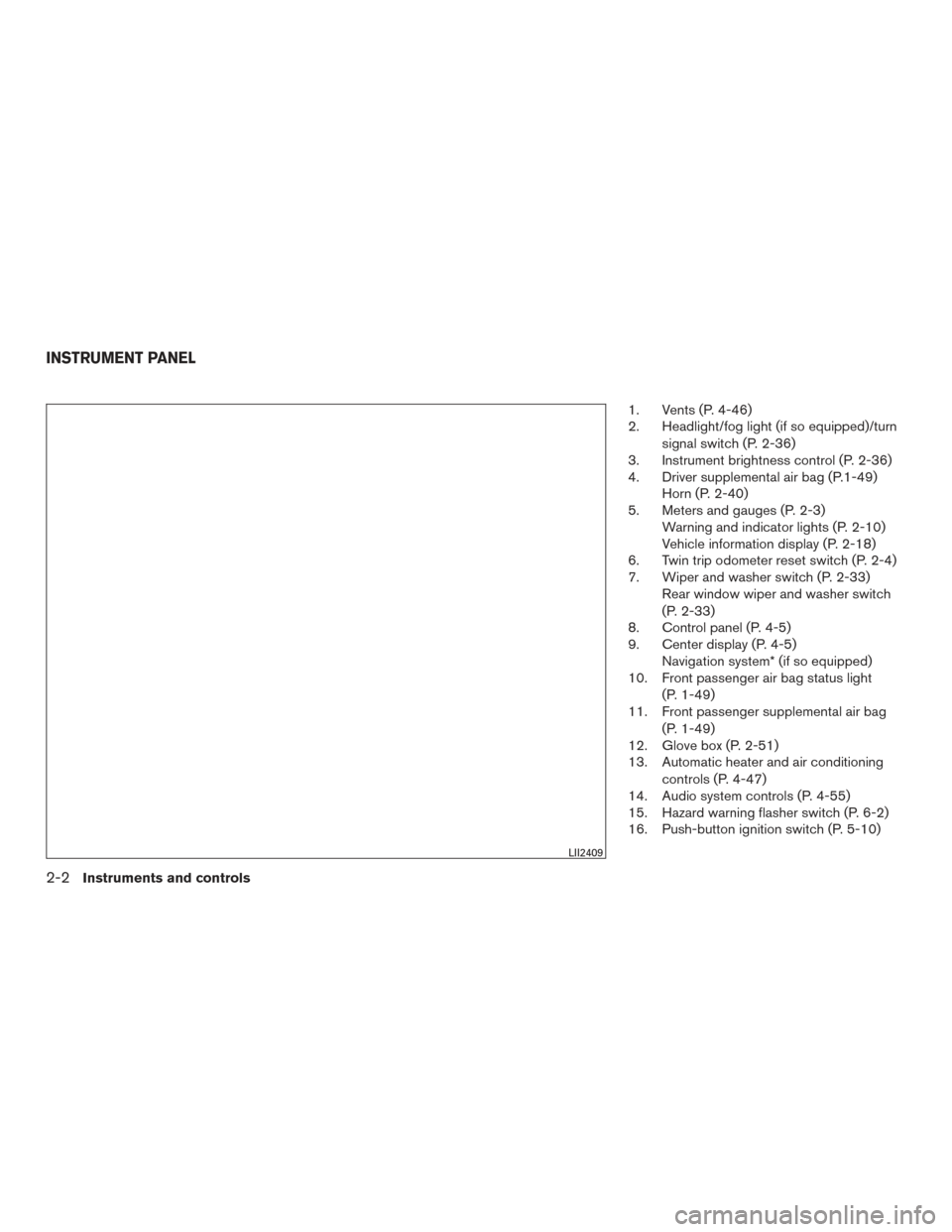
1. Vents (P. 4-46)
2. Headlight/fog light (if so equipped)/turnsignal switch (P. 2-36)
3. Instrument brightness control (P. 2-36)
4. Driver supplemental air bag (P.1-49) Horn (P. 2-40)
5. Meters and gauges (P. 2-3) Warning and indicator lights (P. 2-10)
Vehicle information display (P. 2-18)
6. Twin trip odometer reset switch (P. 2-4)
7. Wiper and washer switch (P. 2-33) Rear window wiper and washer switch
(P. 2-33)
8. Control panel (P. 4-5)
9. Center display (P. 4-5) Navigation system* (if so equipped)
10. Front passenger air bag status light
(P. 1-49)
11. Front passenger supplemental air bag
(P. 1-49)
12. Glove box (P. 2-51)
13. Automatic heater and air conditioning
controls (P. 4-47)
14. Audio system controls (P. 4-55)
15. Hazard warning flasher switch (P. 6-2)
16. Push-button ignition switch (P. 5-10)
LII2409
INSTRUMENT PANEL
2-2Instruments and controls
Page 92 of 555
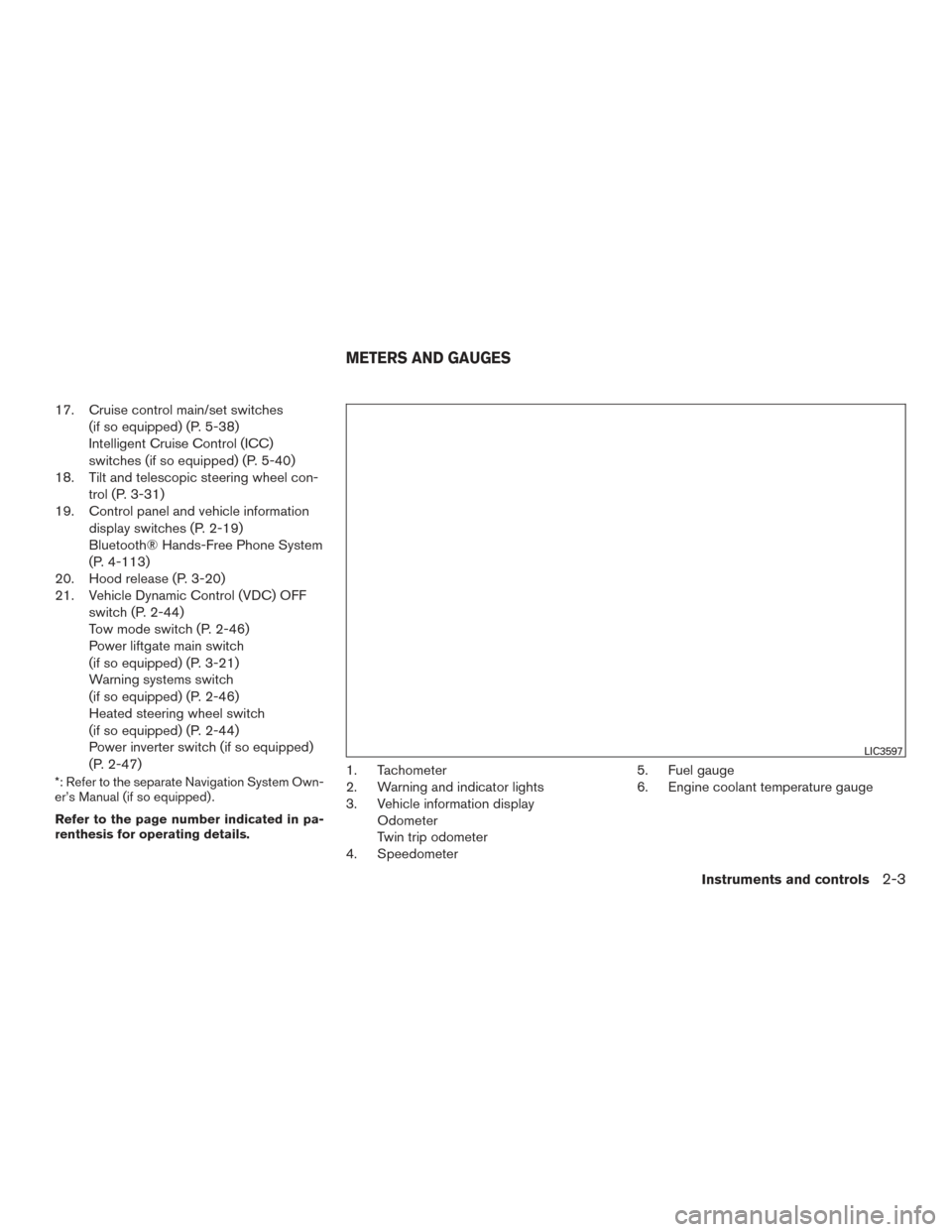
17. Cruise control main/set switches(if so equipped) (P. 5-38)
Intelligent Cruise Control (ICC)
switches (if so equipped) (P. 5-40)
18. Tilt and telescopic steering wheel con-
trol (P. 3-31)
19. Control panel and vehicle information
display switches (P. 2-19)
Bluetooth® Hands-Free Phone System
(P. 4-113)
20. Hood release (P. 3-20)
21. Vehicle Dynamic Control (VDC) OFF
switch (P. 2-44)
Tow mode switch (P. 2-46)
Power liftgate main switch
(if so equipped) (P. 3-21)
Warning systems switch
(if so equipped) (P. 2-46)
Heated steering wheel switch
(if so equipped) (P. 2-44)
Power inverter switch (if so equipped)
(P. 2-47)
*: Refer to the separate Navigation System Own-
er’s Manual (if so equipped) .
Refer to the page number indicated in pa-
renthesis for operating details.1. Tachometer
2. Warning and indicator lights
3. Vehicle information displayOdometer
Twin trip odometer
4. Speedometer 5. Fuel gauge
6. Engine coolant temperature gauge
LIC3597
METERS AND GAUGES
Instruments and controls2-3
Page 166 of 555
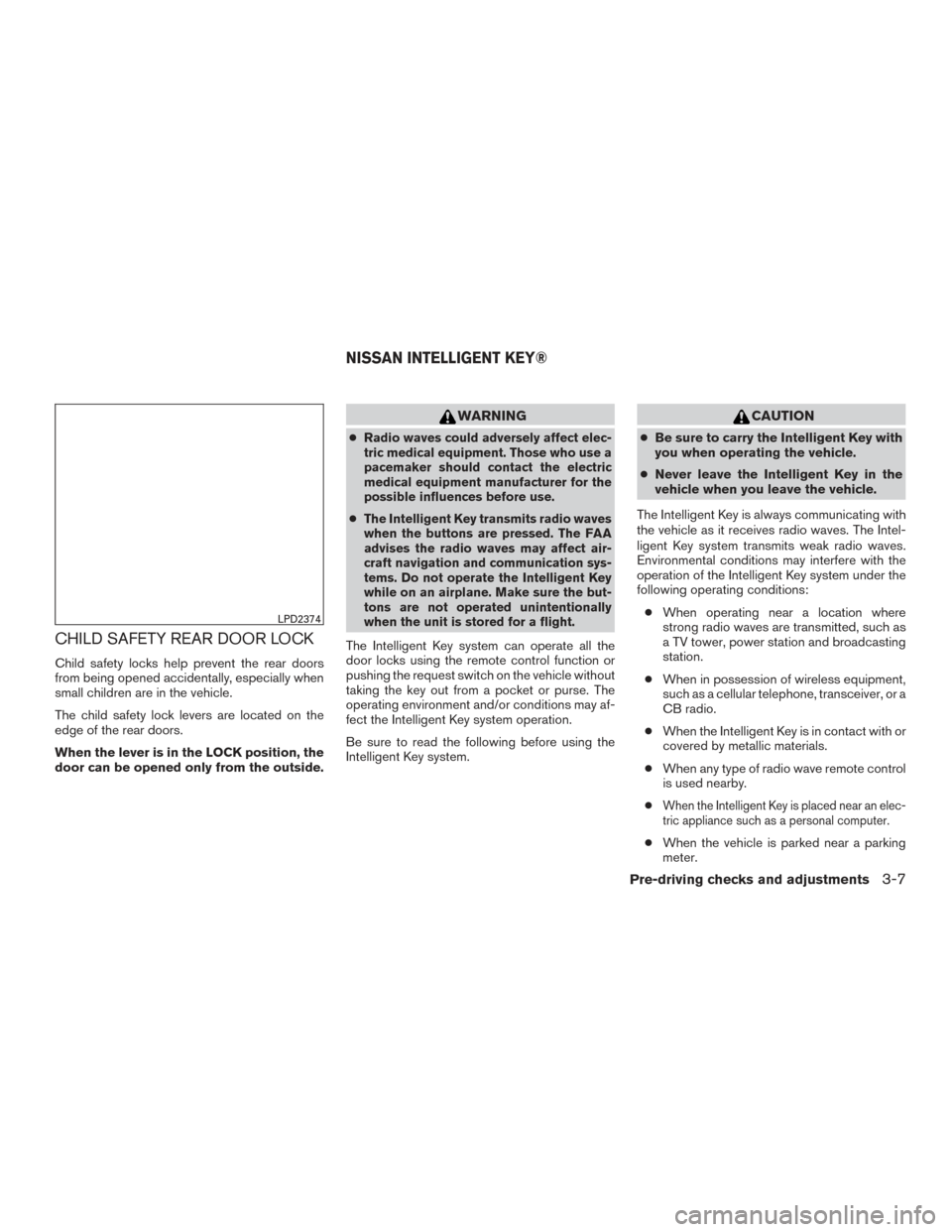
CHILD SAFETY REAR DOOR LOCK
Child safety locks help prevent the rear doors
from being opened accidentally, especially when
small children are in the vehicle.
The child safety lock levers are located on the
edge of the rear doors.
When the lever is in the LOCK position, the
door can be opened only from the outside.
WARNING
●Radio waves could adversely affect elec-
tric medical equipment. Those who use a
pacemaker should contact the electric
medical equipment manufacturer for the
possible influences before use.
●The Intelligent Key transmits radio waves
when the buttons are pressed. The FAA
advises the radio waves may affect air-
craft navigation and communication sys-
tems. Do not operate the Intelligent Key
while on an airplane. Make sure the but-
tons are not operated unintentionally
when the unit is stored for a flight.
The Intelligent Key system can operate all the
door locks using the remote control function or
pushing the request switch on the vehicle without
taking the key out from a pocket or purse. The
operating environment and/or conditions may af-
fect the Intelligent Key system operation.
Be sure to read the following before using the
Intelligent Key system.
CAUTION
●Be sure to carry the Intelligent Key with
you when operating the vehicle.
● Never leave the Intelligent Key in the
vehicle when you leave the vehicle.
The Intelligent Key is always communicating with
the vehicle as it receives radio waves. The Intel-
ligent Key system transmits weak radio waves.
Environmental conditions may interfere with the
operation of the Intelligent Key system under the
following operating conditions: ● When operating near a location where
strong radio waves are transmitted, such as
a TV tower, power station and broadcasting
station.
● When in possession of wireless equipment,
such as a cellular telephone, transceiver, or a
CB radio.
● When the Intelligent Key is in contact with or
covered by metallic materials.
● When any type of radio wave remote control
is used nearby.
●
When the Intelligent Key is placed near an elec-
tric appliance such as a personal computer.
● When the vehicle is parked near a parking
meter.
LPD2374
NISSAN INTELLIGENT KEY®
Pre-driving checks and adjustments3-7
Page 197 of 555
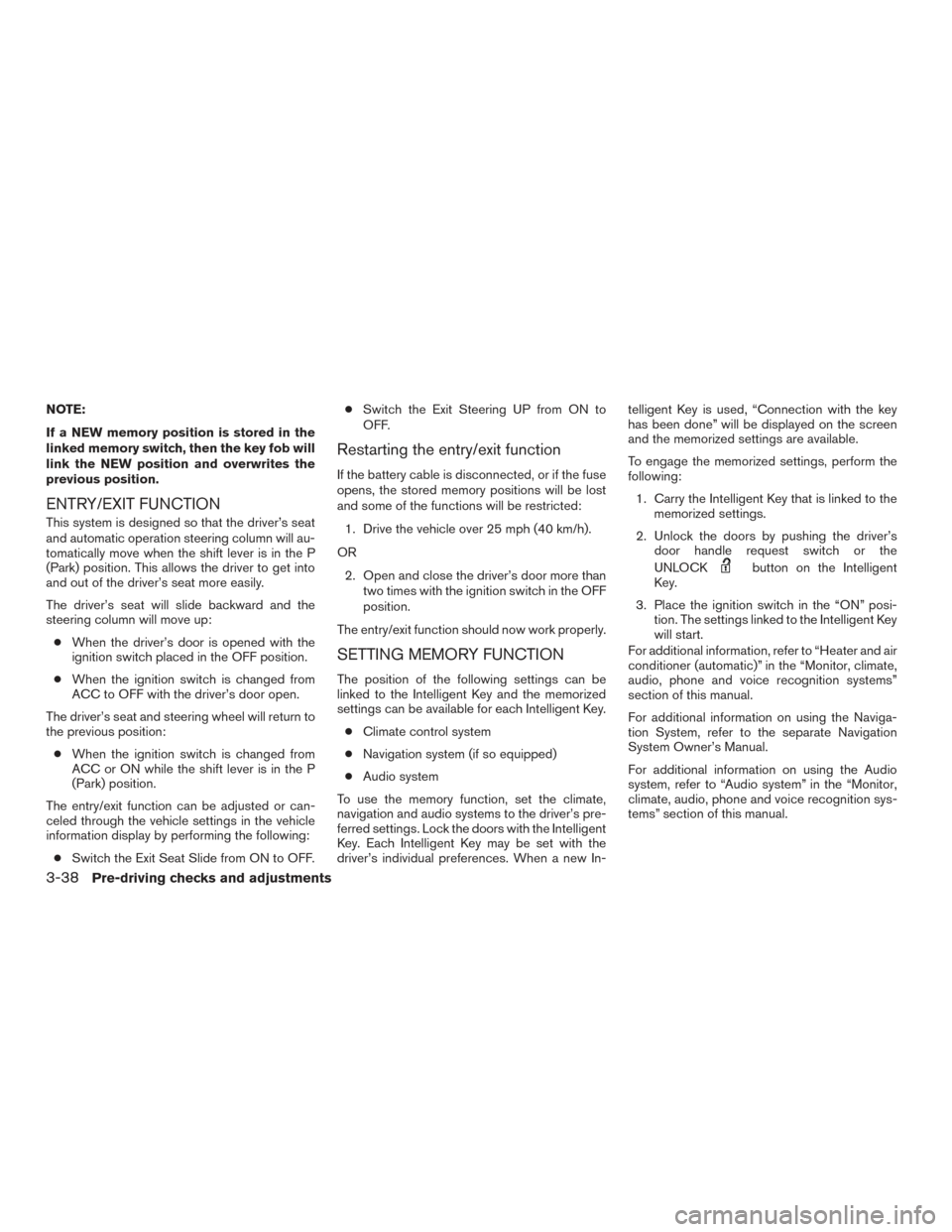
NOTE:
If a NEW memory position is stored in the
linked memory switch, then the key fob will
link the NEW position and overwrites the
previous position.
ENTRY/EXIT FUNCTION
This system is designed so that the driver’s seat
and automatic operation steering column will au-
tomatically move when the shift lever is in the P
(Park) position. This allows the driver to get into
and out of the driver’s seat more easily.
The driver’s seat will slide backward and the
steering column will move up:● When the driver’s door is opened with the
ignition switch placed in the OFF position.
● When the ignition switch is changed from
ACC to OFF with the driver’s door open.
The driver’s seat and steering wheel will return to
the previous position: ● When the ignition switch is changed from
ACC or ON while the shift lever is in the P
(Park) position.
The entry/exit function can be adjusted or can-
celed through the vehicle settings in the vehicle
information display by performing the following: ● Switch the Exit Seat Slide from ON to OFF. ●
Switch the Exit Steering UP from ON to
OFF.
Restarting the entry/exit function
If the battery cable is disconnected, or if the fuse
opens, the stored memory positions will be lost
and some of the functions will be restricted:
1. Drive the vehicle over 25 mph (40 km/h).
OR 2. Open and close the driver’s door more than two times with the ignition switch in the OFF
position.
The entry/exit function should now work properly.
SETTING MEMORY FUNCTION
The position of the following settings can be
linked to the Intelligent Key and the memorized
settings can be available for each Intelligent Key. ● Climate control system
● Navigation system (if so equipped)
● Audio system
To use the memory function, set the climate,
navigation and audio systems to the driver’s pre-
ferred settings. Lock the doors with the Intelligent
Key. Each Intelligent Key may be set with the
driver’s individual preferences. When a new In- telligent Key is used, “Connection with the key
has been done” will be displayed on the screen
and the memorized settings are available.
To engage the memorized settings, perform the
following:
1. Carry the Intelligent Key that is linked to the memorized settings.
2. Unlock the doors by pushing the driver’s door handle request switch or the
UNLOCK
button on the Intelligent
Key.
3. Place the ignition switch in the “ON” posi- tion. The settings linked to the Intelligent Key
will start.
For additional information, refer to “Heater and air
conditioner (automatic)” in the “Monitor, climate,
audio, phone and voice recognition systems”
section of this manual.
For additional information on using the Naviga-
tion System, refer to the separate Navigation
System Owner’s Manual.
For additional information on using the Audio
system, refer to “Audio system” in the “Monitor,
climate, audio, phone and voice recognition sys-
tems” section of this manual.
3-38Pre-driving checks and adjustments
Page 200 of 555
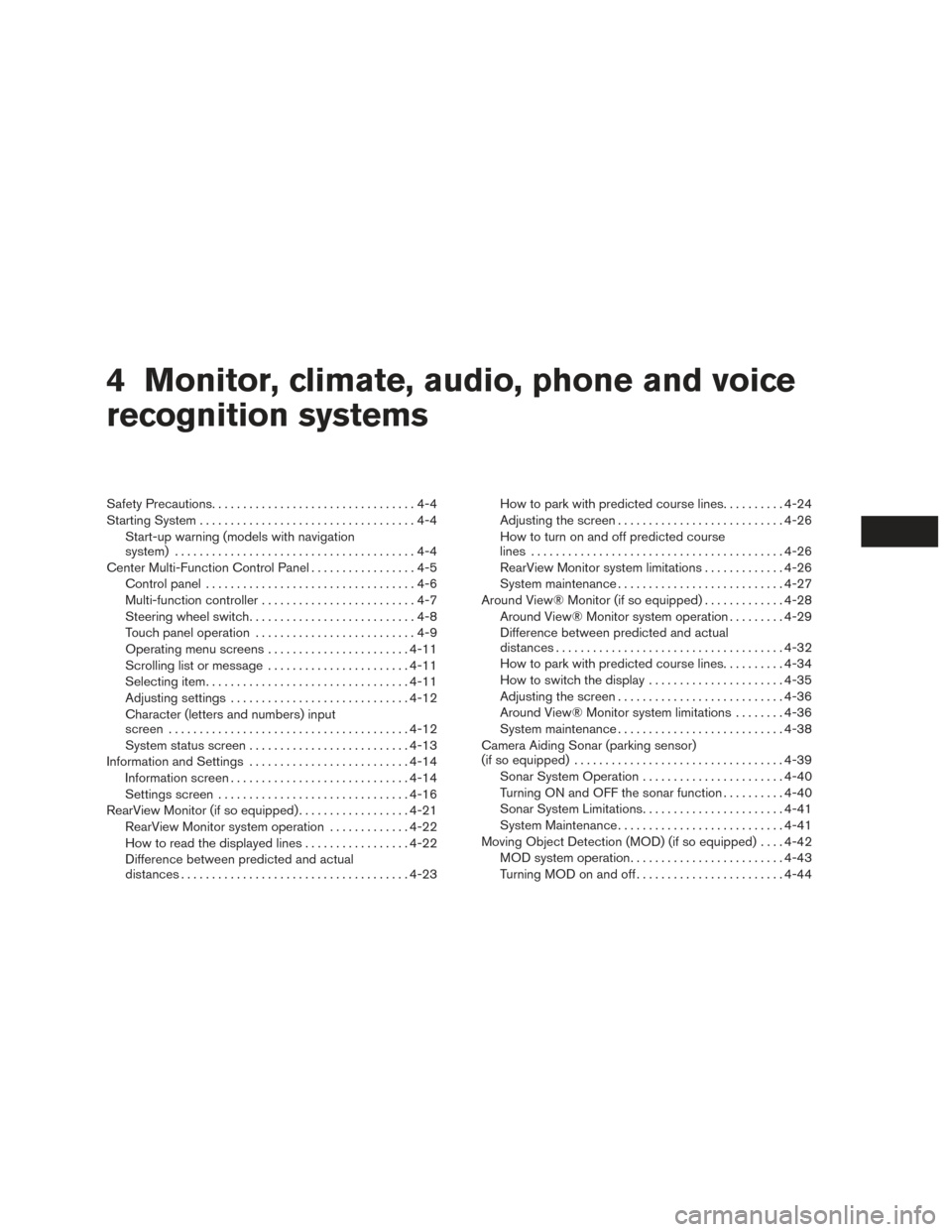
4 Monitor, climate, audio, phone and voice
recognition systems
Safety Precautions.................................4-4
Starting System ...................................4-4
Start-up warning (models with navigation
system) .......................................4-4
Center Multi-Function Control Panel .................4-5
Control panel ..................................4-6
Multi-function controller .........................4-7
Steering wheel switch ...........................4-8
Touch panel operation ..........................4-9
Operating menu screens .......................4-11
Scrolling list or message .......................4-11
Selecting item ................................. 4-11
Adjusting settings ............................. 4-12
Character (letters and numbers) input
screen ....................................... 4-12
System status screen .......................... 4-13
Information and Settings .......................... 4-14
Information screen ............................. 4-14
Settings screen ............................... 4-16
RearView Monitor (if so equipped) ..................4-21
RearView Monitor system operation .............4-22
How to read the displayed lines .................4-22
Difference between predicted and actual
distances ..................................... 4-23How to park with predicted course lines
..........4-24
Adjusting the screen ........................... 4-26
How to turn on and off predicted course
lines ......................................... 4-26
RearView Monitor system limitations .............4-26
System maintenance ........................... 4-27
Around View® Monitor (if so equipped) .............4-28
Around View® Monitor system operation .........4-29
Difference between predicted and actual
distances ..................................... 4-32
How to park with predicted course lines ..........4-34
How to switch the display ......................4-35
Adjusting the screen ........................... 4-36
Around View® Monitor system limitations ........4-36
System maintenance ........................... 4-38
Camera Aiding Sonar (parking sensor)
(if so equipped) .................................. 4-39
Sonar System
Operation ....................... 4-40
Turning ON and OFF the sonar function ..........4-40
Sonar System Limitations .......................4-41
System Maintenance ........................... 4-41
Moving Object Detection (MOD) (if so equipped) ....4-42
MOD system operation ......................... 4-43
Turning MOD on and off ........................ 4-44